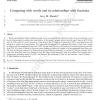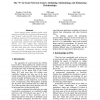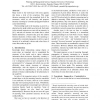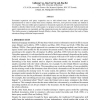2105 search results - page 19 / 421 » Grouping with Directed Relationships |
ISCI
2007
13 years 9 months ago
2007
ct 9 Words mean different things to different people, and so are uncertain. We, therefore, need a fuzzy set model for a word 10 that has the potential to capture their uncertaint...
HICSS
2011
IEEE
13 years 1 months ago
2011
IEEE
Social network games embedded within social network sites (SNSs) such as Facebook facilitate play with “Friends” within the SNS. In this study, we look at different dimensions...
KES
1998
Springer
14 years 2 months ago
1998
Springer
Many events in the world occur with some quantity that shows a level of the occurrence. This paper discusses reasoning with the normalized level of the occurrence, which we call i...
RIAO
2007
13 years 11 months ago
2007
Document expansion and query expansion aim to add related terms into document and query representations in order to make them more complete. However, most previous studies are lim...
EKAW
2008
Springer
13 years 11 months ago
2008
Springer
In this paper, we propose a new methodology based on directed graphs and the TextRank algorithm to automatically induce general-specific noun relations from web corpora frequency c...




